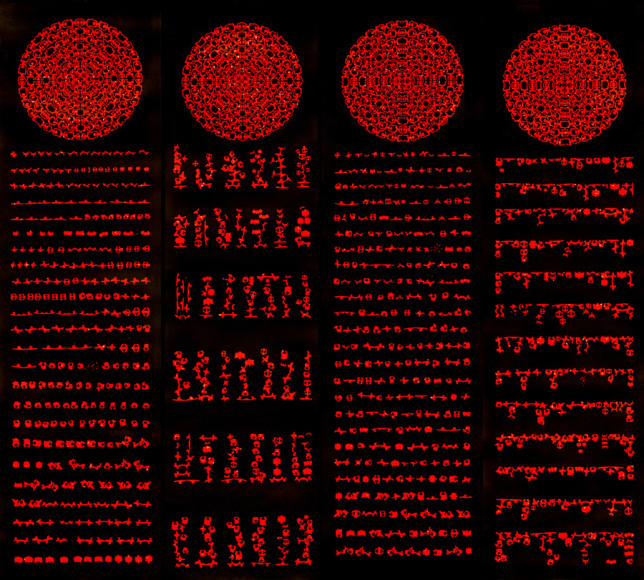Chambers Fine Art is pleased to announce the first exhibition in America of Lu ShengZhong. Born in 1952 in Shandong, Lu ShengZhong grew up during the turbulent years of the Cultural Revolution. He joined the army and held various jobs before deciding to devote himself full- time to art, studying at Shandong Normal University and Central Academy of Fine Arts. For his first major exhibition held at China's National Art Gallery in Beijing, Lu ShengZhong transformed the galleries into a temple filled with a brilliant panoply of cut-out paper forms, henceforth to be his major means of expression.
The ending of the Cultural Revolution led to a tremendous upheaval in the stratified world of Chinese art. As new ideas poured in from the west, young artists who previously had to choose between traditional means of expression and the art for the masses promoted by Mao ZeDong were suddenly exposed to a broad spectrum of modern and contemporary modes of expression. A profusion of short-lived movements and groupings, many with a political edge, soon attracted international attention but to Lu ShengZhong it seemed that much of the work produced was superficial. Thus, he has written in the introduction to the catalogue, "in the mid-1980s I walked away from the cultural confusion of the time, and turned back to the villages, to traditional folk art."
The traditional technique of paper cutting, used extensively in the folk art of China, opened the way for Lu ShengZhong to give striking formal expression to ideas of a philosophical and religious nature. "As I cut paper with my scissors and separate the shapes that result from my activity, I am making a statement against the separation of bodyand soul in contemporary thought. Summoning the detached forms of the souls so that they can be reunited with their bodies, can be compared to the juxtaposition of positive and negative forms or the perfect coexistence of the curves of ying and yang."
Wu Hung, Harrie A. Vanderstappen Distinguished Service Professor at the University of Chicago, has stated, "among a small group of contemporary Chinese artists who have obtained world-wide renown, Lu ShengZhong is unique in his quest to express individuality and contemporaneity through a Chinese vernacular art form - the art of paper cutting."
In choosing the works for this exhibition, Lu ShengZhong has recreated one of his older projects first conceptualized in the late 1980s. This work - Calling Soul - constitute the foundation for all his later artistic experiments. Works created specially for this exhibition include Great Peace and Tranquillity and Poetry of Harmony.
From the Cubist collages of Picasso and Braque to the final works of Matisse, artists in the West have used cut paper forms for a wide variety of formal and expressive purposes. In the hands of Lu ShengZhong, the amazingly intricate cut paper shapes are assembled to establish elaborate installations as well as a series of wall-hangings that utilize positive and negative forms in a lively dialogue.
*Catalogue Available
能有机会首次在美国举办吕胜中的个展,前波画廊深感荣幸。吕胜中于1952年出生在山东,亲历了动荡的文革时期。他参过军,也尝试过其他职业,但最终决定投身艺术。他从山东师范大学一直读到中央美术学院。在北京中国美术馆举行首次重要展览时,他把整个展厅布置得像庙宇一般,四周布满了绚丽的剪纸装饰。这种风格此后也成为他主要的艺术表达方式。
文化大革命的结束给中国的艺术领域带来了剧变。过去,艺术家们只能局限于传统的表现方式,遵循毛泽东倡导的“艺术必须服务人们大众”的指导思想,别无其他选择。随着西方新思潮的大量涌入,他们突然发现自己处在形形色色的现代和当代表现方式的包围中。突然出现而又旋即归于沈寂的运动、团体层出不穷,而且大多带有政治色彩,也因此很快吸引了国际上的注意力。但在吕胜中看来,这个时期的许多作品都流于肤浅。正如他在图录引言中写到“在八十年代中期,我很快从遭受文化撞击的不知所措中抽身而出,又回到中国的乡村,去寻找古老的民间艺术。”
在民间广为流传的剪纸技艺为吕胜中的创作提供了新的思路,表达抽象哲学和宗教观念找到了一种颇具震撼力的表现形式。“通过剪刀对纸的分割过程,去否定魂不附体的病态世界和畸形历史,去演示正反相成、阴阳相合的纯朴与完美。”
芝加哥大学 Harrie A.Vanderstappen 杰出服务教授巫鸿先生评价道:“在已经获得世界声誉的一小部分当代中国艺术家中,吕胜中是非常独特的,他是通过中国本土的艺术形式剪纸艺术来表达其个性和当代性。”
吕胜中为本次展览重新制作了他早期的作品《招魂》,这件构思于80年代末期的作品成为了他此后艺术实验的基础。他专门为这次展览创作的作品有:《大平安》、《和合诗》和《天安门畅想曲》。
从毕卡索、布朗特的立体派抽象拼贴画,到马蒂斯的晚期作品,西方的艺术家基于形式和表达的需要,也广泛地使用着剪纸这种艺术形式。而吕胜中的一双巧手却能将这些错综复杂的剪纸图案拼接为精致的装置作品和墙帷。图案有正反两种形式,似在进行亲密的对话。
*前波画廊为此展览出版了展览图录


